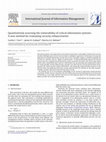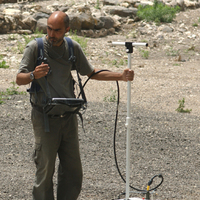Papers by Patricia Ralston
2021 ASEE Virtual Annual Conference Content Access, Jul 26, 2021
Computer Applications in Industry and Engineering, 2005
Computers and Their Applications, 2008
2020 ASEE Virtual Annual Conference Content Access Proceedings, Sep 8, 2020
Polymer Engineering and Science, Dec 1, 1991
American journal of engineering education, Dec 7, 2016

Computers & Operations Research, 1995
Abstract In off-line training of a rule-based controller, the significant measure of successful t... more Abstract In off-line training of a rule-based controller, the significant measure of successful training is the quality of control provided by the generated rule set. In an adaptive or on-line control environment, performance is also measured by the ability to accurately maintain a satisfactory rule set, but within constraints on speed and/or resource availability. Very small population genetic algorithms, or microGAs, have been proposed as a means of capitalizing on the hill climbing characteristics of faster local optimizatiion techniques while requiring less memory and retaining much of the robustness of traditional, larger population genetic search. A traditional genetic algorithm and a similar microGA are developed and applied to two control problems. The performance of these algorithms is analyzed with respect to (1) the quality of the rules learned, (2) the rate at which learning occurs, and (3) the memory resources required during learning.
Cogent Education, Feb 26, 2022

Hydrocarbon Processing, Jul 1, 1993
A controller that uses fuzzy rules provides better response than a conventional linear controller... more A controller that uses fuzzy rules provides better response than a conventional linear controller in some applications. The rules are best implemented as a breakpoint function. A level control example illustrates the technique and advantages over proportional-integral (PI) control. In numerous papers on fuzzy controller development, emphasis has been primarily on formal inferencing, membership functions, and steps in building a fuzzy relation, as described by Zadeh. The rationale used in formulating the required set of rules is usually neglected, and the interpretation of the final controller as an input-output algorithm is overlooked. Also, the details of fuzzy mathematics are unfamiliar to many engineers and the implementation appears cumbersome to most. Process description and control instrumentation. This article compares a fuzzy controller designed by specifying a breakpoint function with a traditional PI controller for a level control system on a laboratory scale. In this discussion, only setpoint changes are considered.
2021 ASEE Virtual Annual Conference Content Access, Jul 26, 2021

International Polymer Processing, Dec 1, 1993
This paper presents the simulation of a typical cyclic polymer processing operation with respect ... more This paper presents the simulation of a typical cyclic polymer processing operation with respect to the performance of different control strategies for part quality when subjected to disturbances with realistic load-profiles. Disturbances enter the simulation in a complex, probabilistic manner creating a unique flexibility in load representation which helps the simulation more accurately capture the performance of real processing operations. Realistic simulations can provide necessary information and be less costly than benchmark studies on actual processes. The objective of the research is to examine the effect of different control strategies on the overall control of part-to-part quality, not the control of the continuous processes that occur in part fabrication. The performance of six different control strategies is compared; two strategies are conventional feedback, and four strategies are statistically based. The statistically based algorithms effect closed loop control, but only when a true load exists. Results are analyzed using statistical analysis of variance (ANOVA) via a completely randomized block experimental design, and Duncan's multiple range test is used to rank the control strategies. The results indicate that as more disturbances enter the system, the conventional controllers perform better than the other strategies. When fewer disturbances are present, however, the statistically based controllers perform better. The most notable result is that one statistically based controller, the Western Electric runs rules controller, performs well over the entire range of disturbances.

Journal of Engineering Education, 2018
Background The first semester in undergraduate engineering is often challenging for students, mak... more Background The first semester in undergraduate engineering is often challenging for students, making this a potentially fruitful time period for exploring motivational changes and relations between motivational beliefs and achievement. Purpose/Hypothesis The purpose of the current study was to examine changes in implicit beliefs about intelligence and effort beliefs across the first semester of undergraduate engineering education, to investigate how these beliefs may contribute to first-semester achievement, and to explore changes in students' perceptions of the relative contributions of effort and ability/intelligence to grades. Design/Method Data from first-time, full-time engineering undergraduates at a large Midwestern university were collected at Weeks 1 and 13 of the first semester. Analyses were replicated across two cohorts (2013 and 2014). Results On average, students entered and ended the semester with relatively incremental and positive effort beliefs. Surprisingly, incremental beliefs did not predict grade point average (GPA). Positive effort beliefs were associated with GPA in both cohorts. Findings regarding the role that perceived effort plays in achievement were replicated across cohorts. The average trajectory was as follows: at Week 1, students perceived that ability/intelligence was the primary contributor to high school achievement but anticipated that effort would play a greater role in undergraduate coursework; at Week 13, students on average reflected that the role of effort was less than originally anticipated. Conclusion Although implicit beliefs about intelligence and effort beliefs remained fairly stable across the first semester, students in both cohorts exhibited similar shifts in perceptions of the importance of effort (relative to ability/intelligence) for academic success.

International Journal of Mathematical Education in Science and Technology, Jun 15, 2010
ABSTRACT In fall 2007, J.B. Speed School of Engineering at the University of Louisville joined th... more ABSTRACT In fall 2007, J.B. Speed School of Engineering at the University of Louisville joined the ranks of universities requiring the purchase of Tablet PCs for all new entering students. This article presents a description of how the Department of Engineering Fundamentals incorporated Tablet PCs into their instruction, a review of the literature pertaining to the use of Tablet PCs for instruction and preliminary survey results from the students in engineering mathematics courses at the end of the first year, after students had been exposed to Tablet PCs for 1 year. Results show that a large majority of students in the Department of Engineering Fundamentals agree that presentation of engineering mathematics material using the Tablet PCs and DyKnow software is a vast improvement over overhead projector, blackboard, or PowerPoint lectures and course packs. However, students are split as to whether the Tablet PC is something they actually want to use for their own note-taking. Finally, a plan for assessment of tablet impact on student learning is presented.

International Journal of Information Management, Dec 1, 2008
This paper proposes a new approach for assessing the organization's vulnerability to information-... more This paper proposes a new approach for assessing the organization's vulnerability to information-security breaches. Although much research has been done on qualitative approaches, the literature on numerical approaches to quantify information-security risk is scarce. This paper suggests a method to quantify risk in terms of a numeric value or "degree of cybersecurity". To help quantitatively measure the level of cybersecurity for a computer-based information system, we present two indices, the threat-impact index and the cyber-vulnerability index, based on vulnerability trees. By calculating and comparing the indices for various possible security enhancements, managers can select the best security enhancement choice, prioritize the choices by their relative effectiveness, and statistically justify spending resources on the selected choice. By qualifying information security quantitatively, the method can also help managers establish a specific target of security level that they can track. We illustrate the use of the proposed methodology on the security of supervisory control and data acquisition (SCADA) systems using data from the SCADA system test bed implemented at the University of Louisville as a case study, and then show the use of the proposed indices on this information system before and after two security enhancements.
She will receive a PHD in Education Leadership, Foundations and Human Development from the Univer... more She will receive a PHD in Education Leadership, Foundations and Human Development from the University of Louisville in May 2014. She has held positions in engineering and management for Axxess Technologies, Varian, Amoco and Corning, and has taught in industry, at community college and at the graduate and undergraduate levels. Her research interests include engineering student performance and retention, and how to best teach work skills throughout the engineering curriculum.

Computers & Industrial Engineering, 1987
There has been considerable attention to applications of feedback control to machine tools. Certa... more There has been considerable attention to applications of feedback control to machine tools. Certainly all computer numerically controlled (CNC) machines use servomechanisms for the spindle and feed drives. When feedback control is extended to the metal cutting process itself, there has been an unfortunate tendency to call such systems adaptive controls, for example, adaptive control constraint (ACC) .and adaptive control optimization (ACO), even though they have not been adaptive in the sense of modern control theory. A special name, parameter adaptive control, has been proposed to describe the application of truly adaptive control to metal cutting. Even though there is substantial work on adaptive control within the body of modern control theory, there have been few reductions of parameter adaptive control to actual machine tools. It has been suggested that the primary impediments to such application are the lack of mathematical models of manufacturing processes in forms appropriate to the control problem, and the lack of in-process sensing techniques that would be complementary to such models. This paper describes one step in a sequence of research efforts that is intended to lead to the adaptive control of unattended machine tools. Numerical parameters are used to evaluate coefficients of a previously developed state space model of semi-orthogonal metal cutting on a lathe. An Advanced Continuous Simulation Language (ACSL) program is presented.








Uploads
Papers by Patricia Ralston